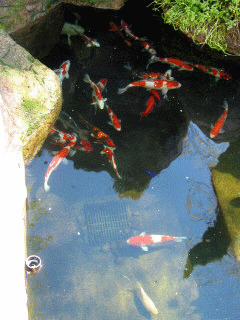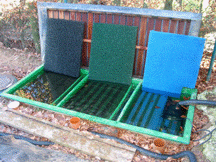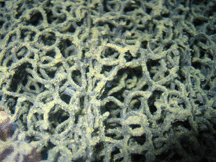Spring is one of the worst times of the year for Koi,
there are so many things to deal with.
There's the water temperatures that have more ups and downs
than a roller coaster. Then there's the large amount of predators
that are probably really hungry and are
looking for a nice fresh meal after a long winter.
after a long winter.
Don't forget Aeromonas Alley, the danger zone of 40°F - 50°F where your Koi's immune system is shut down, but harmful bacteria are still active. Your Koi are also have to deal with those life draining organisms, parasites.
looking for a nice fresh meal
 after a long winter.
after a long winter. Don't forget Aeromonas Alley, the danger zone of 40°F - 50°F where your Koi's immune system is shut down, but harmful bacteria are still active. Your Koi are also have to deal with those life draining organisms, parasites.
But don't let all that get you down. The best thing that you can do for your Koi are supplying them with adequate Oxygen and making sure they have as little stress as possible. If you are lucky enough to have a pond heating system, you should get through that 40°F - 50°F zone as quick as possible.
You can also use it to keep those
temperature fluctuations in check.
You can also use it to keep those
temperature fluctuations in check.
Keep a close eye on your Koi. Look for any signs of distress,
like an ulcer or if your Koi isn't swimming right. If you do have an emergency,
get in contact with a veterinarian that is knowledgeable in Koi health.
Start feeding your Koi when the water temperature is constantly above 50°F.
A good rule of thumb is:
If your Koi are begging for food at the surface of the water,
their probably hungry and have decided for themselves
that it is time to start eating. It is a good idea to use a
Koi food that is high in wheat germ, it is easy to digest.

 A swimming pool owner wants to achieve filtration that guarantees clean and nearly sterilized water.
A swimming pool owner wants to achieve filtration that guarantees clean and nearly sterilized water.  Basically, proper size filter tanks and type of media with regards to flow rate, fish density and cleaning routine are the tools that can help you to create pond stability. Simply put, ponds with inadequate filter systems tend to require "disruptive cleaning".
Basically, proper size filter tanks and type of media with regards to flow rate, fish density and cleaning routine are the tools that can help you to create pond stability. Simply put, ponds with inadequate filter systems tend to require "disruptive cleaning". 
